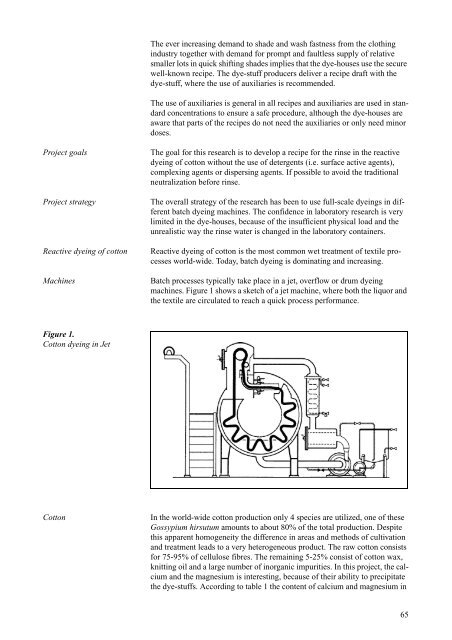Cleaner Technology Transfer to the Polish Textile ... - Miljøstyrelsen
Cleaner Technology Transfer to the Polish Textile ... - Miljøstyrelsen
Cleaner Technology Transfer to the Polish Textile ... - Miljøstyrelsen
You also want an ePaper? Increase the reach of your titles
YUMPU automatically turns print PDFs into web optimized ePapers that Google loves.
The ever increasing demand <strong>to</strong> shade and wash fastness from <strong>the</strong> clothing<br />
industry <strong>to</strong>ge<strong>the</strong>r with demand for prompt and faultless supply of relative<br />
smaller lots in quick shifting shades implies that <strong>the</strong> dye-houses use <strong>the</strong> secure<br />
well-known recipe. The dye-stuff producers deliver a recipe draft with <strong>the</strong><br />
dye-stuff, where <strong>the</strong> use of auxiliaries is recommended.<br />
The use of auxiliaries is general in all recipes and auxiliaries are used in standard<br />
concentrations <strong>to</strong> ensure a safe procedure, although <strong>the</strong> dye-houses are<br />
aware that parts of <strong>the</strong> recipes do not need <strong>the</strong> auxiliaries or only need minor<br />
doses.<br />
Project goals The goal for this research is <strong>to</strong> develop a recipe for <strong>the</strong> rinse in <strong>the</strong> reactive<br />
dyeing of cot<strong>to</strong>n without <strong>the</strong> use of detergents (i.e. surface active agents),<br />
complexing agents or dispersing agents. If possible <strong>to</strong> avoid <strong>the</strong> traditional<br />
neutralization before rinse.<br />
Project strategy The overall strategy of <strong>the</strong> research has been <strong>to</strong> use full-scale dyeings in different<br />
batch dyeing machines. The confidence in labora<strong>to</strong>ry research is very<br />
limited in <strong>the</strong> dye-houses, because of <strong>the</strong> insufficient physical load and <strong>the</strong><br />
unrealistic way <strong>the</strong> rinse water is changed in <strong>the</strong> labora<strong>to</strong>ry containers.<br />
Reactive dyeing of cot<strong>to</strong>n Reactive dyeing of cot<strong>to</strong>n is <strong>the</strong> most common wet treatment of textile processes<br />
world-wide. Today, batch dyeing is dominating and increasing.<br />
Machines Batch processes typically take place in a jet, overflow or drum dyeing<br />
machines. Figure 1 shows a sketch of a jet machine, where both <strong>the</strong> liquor and<br />
<strong>the</strong> textile are circulated <strong>to</strong> reach a quick process performance.<br />
Figure 1.<br />
Cot<strong>to</strong>n dyeing in Jet<br />
Cot<strong>to</strong>n In <strong>the</strong> world-wide cot<strong>to</strong>n production only 4 species are utilized, one of <strong>the</strong>se<br />
Gossypium hirsutum amounts <strong>to</strong> about 80% of <strong>the</strong> <strong>to</strong>tal production. Despite<br />
this apparent homogeneity <strong>the</strong> difference in areas and methods of cultivation<br />
and treatment leads <strong>to</strong> a very heterogeneous product. The raw cot<strong>to</strong>n consists<br />
for 75-95% of cellulose fibres. The remaining 5-25% consist of cot<strong>to</strong>n wax,<br />
knitting oil and a large number of inorganic impurities. In this project, <strong>the</strong> calcium<br />
and <strong>the</strong> magnesium is interesting, because of <strong>the</strong>ir ability <strong>to</strong> precipitate<br />
<strong>the</strong> dye-stuffs. According <strong>to</strong> table 1 <strong>the</strong> content of calcium and magnesium in<br />
65

















